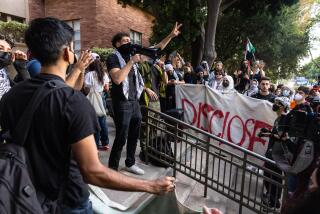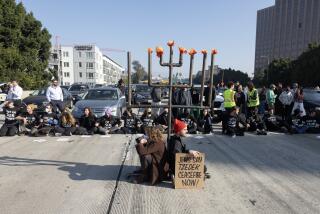Fed Up, Marchers Demand an End to Killing
Spilling into the busy intersection of Western Avenue and 44th Street, nearly 200 people descended on a South Los Angeles doughnut shop where, three months earlier, a 17-year-old gang member fatally shot 14-year-old Clive Jackson Jr.
This night, a coalition of community groups, churches, friends and family, crowded the sidewalks, rushed cars at red lights and greeted curious neighbors standing on porches with a simple but urgent message: âStop the killing! Stop the violence!â
This was one homicide site of nearly 100 visited by the Stop the Killinâ Campaign over the last year since Inglewood resident Ed Turley, angered by the escalating number of killings, took action.
According to Los Angeles Police Department statistics, there were 658 homicides in 2002 -- a 10% increase from 2001. More than a third of those slayings occurred in South Los Angeles.
âI donât think everyone realizes that everyoneâs tired of the killing,â said Turley, executive director of the Central Recovery and Development Project, a gang intervention nonprofit based in South Los Angeles.
Turley said the campaign wants to embolden community members.
âGangs have only as much power as we give them,â said youth minister Milo Carrasco. âIf people wake up and realize that thereâs more of us than them, we can do something.â
Although the marches have focused on neighborhoods in South Los Angeles, Turley said the group is willing to go anywhere where thereâs been a killing. Turley said he wants all of Los Angeles to know that violence affects everybody, no matter where they live.
Ultimately, Turley said, the goal is to become a successful media campaign like Mothers Against Drunk Driving. âWe want the same type of national recognition of the violence and the same national type of impact to reduce it,â said Turley.
His idea has mushroomed, moving beyond his organization to include more than a dozen groups. One such group is First AME Menâs Bible Ministries in South Los Angeles.
âThe only way it stops is when the community comes out as a force to say, âWeâre not going to allow it to happen. Weâre not afraid of you,â â said the Rev. Al Washington, executive director of the ministries.
The Stop the Killinâ Campaign has increased its marches from once to twice a month after a surge of killings in November: 18 homicides in seven days, including the slaying of Clive Jackson Jr.
The march for him began as most demonstrations do, with participants gathering in a parking lot for a rousing prayer before driving to the site of a killing in a caravan of cars, often escorted by black-and-white LAPD patrol cars. Then they march. Typically, they visit several homicide sites in one night.
At each site, often with the victimâs family, marchers light candles, offer prayers and huddle together, their outreached hands touching.
Standing at the doughnut shop where Jackson was shot and killed last November, his best friend, Alonzo Fuller, 14, unsuccessfully tried to hold back his tears. His face flush, he shook his head as friends came to his side.
The death of Jackson, who was not a gang member, was cited by Mayor James K. Hahn and Police Chief William J. Bratton as they sought last fall to rally the public against gang violence.
âI thought it was too early for him to go,â Alonzo said. This march, held in the LAPDâs 77th Street Division, was his first.
Wearing baggy sweatshirts adorned with Jacksonâs picture, an airbrushed memorial, Jacksonâs other friends silently bowed their heads.
Families said the vigils help.
âIt gets my anger out,â said Jacksonâs mother, Sharon Smith. She said she hopes other parents will join the anti-violence campaign.
As Smith and others marched, people along the way joined them, coming out of their homes and off the street. Some prayed, others voiced their support.
On another night, this time in the LAPDâs Southwest Division, 17-year-old Brandon Smith, drawn to the noise, came to the corner of 29th Street and Crenshaw Boulevard where two young men were killed in December.
Pointing to a scar on his face, one of three wounds he suffered several months ago in a drive-by shooting, he said it was âtime for someone to speak up.â
Smith, who said he was not in a gang, was shot as he and a friend were walking down a street.
At another location on the same evening, Kim Battle, with her arms braced against the evening chill, stood on the curb intently watching the marchers entering the Baldwin Village neighborhood.
Usually, Battle is too scared to come out at night. But when she heard the chants of marchers, âI felt compelled to.â
There have been eight homicides in the neighborhood within the last 13 months. The area encompasses about one square mile. âPeople just canât stand by and let this go on,â Battle said.
Capt. James Miller of the 77th Street Division is a big supporter.
His division was hit hardest by last yearâs homicide increase. According to Miller, there were 116 homicides in the 11 square miles patrolled that 77th officers. That was 52 more than any other LAPD division.
âItâs important,â said Miller, âto reassure the community they donât stand alone in the face of crime.â
Miller said he has attended many of the marches, providing at least four patrol cars and eight officers as escorts that halt traffic for the motorcade.
âIn some of the areas where weâve done the marches, weâve actually noticed a decrease in homicides,â said Miller.
Coalition members vow to continue indefinitely.
Gerald Thompson, executive director of Frontline Soldiers, a mentoring nonprofit, said, âWeâre not going to stop marching until they stop killing.â
More to Read
Sign up for Essential California
The most important California stories and recommendations in your inbox every morning.
You may occasionally receive promotional content from the Los Angeles Times.










